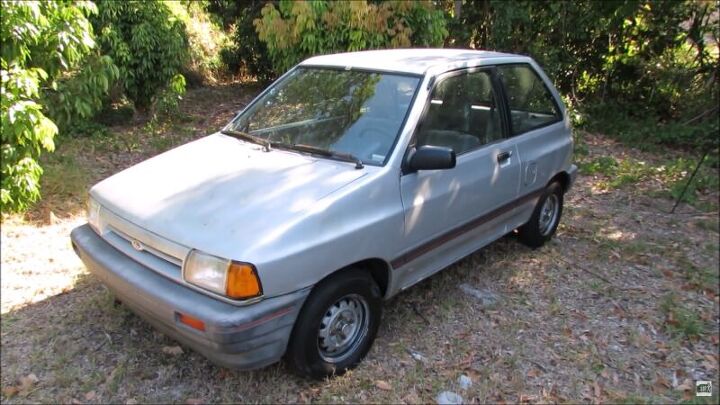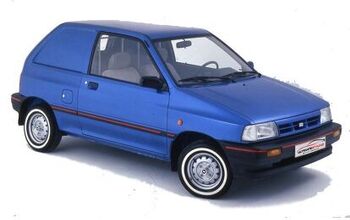Rare Rides Icons: The Ford Festiva, a Subcompact and Worldwide Kia by Mazda (Part I)

We embark on the important and global tale of a subcompact hatchback today. Your author referenced it last week in Part I of our Kia large cars series, and now it’s time for the promised comprehensive Rare Rides coverage! Manufactured in various places around the world, our subject vehicle lived a long life and had no fewer than 10 identities over its impressive 17-year span. We’re going to party, karamu, Festiva, forever.
The Festiva’s tale started in the Seventies, as Ford increased its ownership stake in friendly and wholesome Japanese automaker, Mazda. The two companies’ relationship started in the latter part of that decade. Mazda had been in a rough spot financially since the Sixties, and Ford purchased its ownership on the cheap. Ford’s first investment was a paltry seven percent stake in the Hiroshima firm.
The relationship deepened in 1979 when Ford poured in some more cash and raised their stake in Mazda to 24.5 percent. The timing happened to align for both companies with regard to an all-new subcompact offering, as Ford’s product was outdated and Mazda had some free design capacity.
As far as Ford was concerned, subcompact offerings were split into the Pinto for the North American market, and the Fiesta for Europe and other places. The Pinto had a terrible reputation and was near the end of its life after being on sale since 1971.
The West German and UK-made Fiesta was a bit newer, but wouldn’t last much longer in its first-gen Seventies guise. On sale since 1976, German examples were available in North America between 1978 and 1980. The first Fiesta was generally well-received, particularly in North America because the Pinto alternative was crap.
The Fiesta continued in production through 1983 in its initial version, before it was replaced by the Fiesta Mark II. But that Fiesta, like the first, was more for European consumption and wouldn’t work as a world car as well as something purpose-designed. Hold that thought.
Over at Mazda, there was only one subcompact car in the company’s history, and it was only such on a technicality. Called the Carol 600, the coupe and sedan were marginally larger versions of the Kei R360 coupe, which was also sold as the Carol. Its 600 name was due to its 586-cc engine, and it graduated from Kei to subcompact because it had larger bumpers. Inside, the space was the same as the smaller car.
The “larger” Carol 600 was of a higher tax bracket and proved unpopular because it offered no advantages over the Kei version other than a larger engine. The 600 was on sale for two model years before it was pulled from production, with about 8,800 examples sold. Mazda didn’t make another subcompact until 1986. Back to Ford.
Given the Pinto was done and the Fiesta was not intended for North American consumption, Ford would go without a subcompact offering for a few years. In 1981 the compact Escort became the replacement for the subcompact Pinto, which had straddled the size classes with how large it was. The replacement for the Fiesta in North America would be a true subcompact.
In Europe, the Fiesta Mark II would continue as the smallest car on offer in the supermini class, while the European Escort was in its third generation and was considered a small family car (compact). The newly created subcompact would not be sold in Europe but would be sold eventually by Ford Australia to that market.
Product need analyzed, Ford approached Mazda with its considerable early Eighties ownership stake and directed the Hiroshima folks to develop a new subcompact car. The name Ford picked was Festiva, surely in hopes the reputation and success of the extant and similarly named Fiesta would rub off on its new import. The resultant Mazda-developed ride was a practical, square, three-door hatchback shape.
Though it wore a Ford badge, it was immediately clear the Festiva was a Japanese design. Its overall theme was “practical box.” An unadorned fascia presented two square composite headlamps, which were flush with the grille and used amber corner markers. The grille between was body-colored and featured a very simple singular bar with a Ford emblem in the center. The bumper was finished in a grey rubber (or body-colored on higher trims) and had almost no decoration other than two turn indicator lamps.
The hood had minimal decoration and only a modest power bulge that tapered off before the leading edge at the grille. The upper half of the Festiva’s hood had a single raised detail, in the form of a centrally-placed black plastic windshield sprayer nozzle.
Fenders featured a single character line that ran straight to the end of the short body. It was interrupted by a very obvious fuel door on the driver’s side, and a black door handle that was pulled from the Ranger. Side rub strips continued from front to rear wheel well and featured a contrasting tape stripe within them. They were black on lower-end models, but body-colored if a more zesty trim.
At the rear, the tall greenhouse met with a simple rear hatch for maximum practicality and visibility. Pillars all around were thin, a nod to the rather lax crash safety standards of the Eighties. There was little adornment at the rear, just a simple set of badges, a rear wiper, and a bumper with a cutout for the tiny tailpipe.
As one might expect on such a class of car, the Festiva’s interior was built to a price and utilized a less is more design theme. In front of the driver was a two-spoke Mazda steering wheel, and beyond a very simple set of gauges. Speedometer, temperature, and fuel were the only gauges offered. No tachometer was present, even with a manual transmission. Elsewhere, the cabin had very simple HVAC sliders, a very simple stereo, and no center console. Between the flat bucket seats was the shifter and parking brake, and nothing else.
The Festiva’s seats were rather unadorned, though some examples used more upmarket ribbed velour as their seating material. Door panels were equally simple, covered with a minimum amount of padding, and finished largely in vinyl. Seat belts were everyone’s least favorite type: Automatic and attached to the door for the shoulder, with a manual lap belt. In general, comfort and convenience features were kept at a minimum, in order to ensure the lowest pricing possible.
There’s not a lot left to say about the exterior and interior styling of the super simplistic Festiva. We’ll wrap up there, and learn about the Festiva’s engineering and mechanicals in Part II. We’ll also cover its important world debut.
[Images: Ford, YouTube]

Interested in lots of cars and their various historical contexts. Started writing articles for TTAC in late 2016, when my first posts were QOTDs. From there I started a few new series like Rare Rides, Buy/Drive/Burn, Abandoned History, and most recently Rare Rides Icons. Operating from a home base in Cincinnati, Ohio, a relative auto journalist dead zone. Many of my articles are prompted by something I'll see on social media that sparks my interest and causes me to research. Finding articles and information from the early days of the internet and beyond that covers the little details lost to time: trim packages, color and wheel choices, interior fabrics. Beyond those, I'm fascinated by automotive industry experiments, both failures and successes. Lately I've taken an interest in AI, and generating "what if" type images for car models long dead. Reincarnating a modern Toyota Paseo, Lincoln Mark IX, or Isuzu Trooper through a text prompt is fun. Fun to post them on Twitter too, and watch people overreact. To that end, the social media I use most is Twitter, @CoreyLewis86. I also contribute pieces for Forbes Wheels and Forbes Home.
More by Corey Lewis
Latest Car Reviews
Read moreLatest Product Reviews
Read moreRecent Comments
- ToolGuy First picture: I realize that opinions vary on the height of modern trucks, but that entry door on the building is 80 inches tall and hits just below the headlights. Does anyone really believe this is reasonable?Second picture: I do not believe that is a good parking spot to be able to access the bed storage. More specifically, how do you plan to unload topsoil with the truck parked like that? Maybe you kids are taller than me.
- ToolGuy The other day I attempted to check the engine oil in one of my old embarrassing vehicles and I guess the red shop towel I used wasn't genuine Snap-on (lots of counterfeits floating around) plus my driveway isn't completely level and long story short, the engine seized 3 minutes later.No more used cars for me, and nothing but dealer service from here on in (the journalists were right).
- Doughboy Wow, Merc knocks it out of the park with their naming convention… again. /s
- Doughboy I’ve seen car bras before, but never car beards. ZZ Top would be proud.
- Bkojote Allright, actual person who knows trucks here, the article gets it a bit wrong.First off, the Maverick is not at all comparable to a Tacoma just because they're both Hybrids. Or lemme be blunt, the butch-est non-hybrid Maverick Tremor is suitable for 2/10 difficulty trails, a Trailhunter is for about 5/10 or maybe 6/10, just about the upper end of any stock vehicle you're buying from the factory. Aside from a Sasquatch Bronco or Rubicon Jeep Wrangler you're looking at something you're towing back if you want more capability (or perhaps something you /wish/ you were towing back.)Now, where the real world difference should play out is on the trail, where a lot of low speed crawling usually saps efficiency, especially when loaded to the gills. Real world MPG from a 4Runner is about 12-13mpg, So if this loaded-with-overlander-catalog Trailhunter is still pulling in the 20's - or even 18-19, that's a massive improvement.









































Comments
Join the conversation
I admired these when they were around. However, I helped a buddy locate a rear axle for this pickup truck at various junk yards. At each, I noted the Festivas were crunched like a tin can. I decided to keep driving my Cutlass Supreme for a few more years. 🚗🚗🚗
Believe it or not, I bought the Festiva as a project car, just last year actually. It is a 1993 Festiva L, with GL parts, and did a few customizations over this year. I swap it to a truck on nice days, and back into a hatchback on colder days. Just my style, I guess. ¯\_(ツ)_/¯ Anyway, how should I know? When I bought the Festiva it was in a field. A perfect project. Soon, it will be part of Derka Rally, hoping Mercedes will sponsor me. I own a 2010 Ram 2500 and a 2016 Ford Explorer.